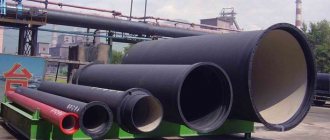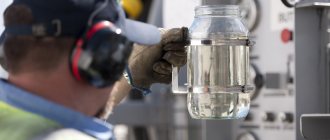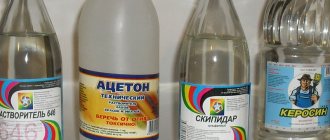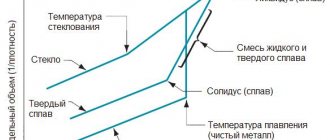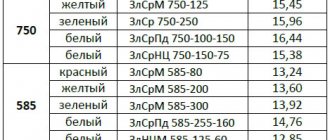Kerosene is a flammable mixture of liquid carbohydrates obtained by direct distillation or oil rectification process, as well as secondary oil refining with hydrotreating if necessary. This mixture is colorless, slightly oily to the touch and has a boiling point of 150 to 250 degrees Celsius.
The use of kerosene is different. It is used as a combustible component of liquid rocket fuel, as jet fuel, as a fuel for firing porcelain and glass products, in various metal cutting apparatus, for household lighting and heating devices, and also as a solvent and raw material for oil refining industries.
This type of material got its name “Kerosene” thanks to the English word “kerosene”, which in turn comes from the Greek word “κηρός”, which means wax.
When working with kerosene, it is important to consider its quality. A parameter such as the specific gravity of kerosene will help determine this.
Story
Information about the distillation of oil begins in the 10th century AD. However, distillation products were not widely used despite information about the use of oil in oil lamps. The industrial use of light petroleum products in lighting began in the 40-50s of the 19th century. Various people have demonstrated the production of a light, low-odor flammable liquid by distillation from coal, bitumen, and oil. A number of patents were obtained. In 1851, the first industrial distillation plant in England came into operation. In 1854 the trademark “kerosene” was registered. The process of adapting oil lamps into a kerosene lamp began. In 1853, in Lviv, workers at the pharmacy of Peter Mikolyash “Under the Golden Star”, Ignatiy Lukasiewicz and Jan Zeg developed a method for distilling and purifying oil. Now it was possible to begin the production of kerosene, or “new campine”, as Lukashevich called kerosene. In December 1853, scientists received an Austrian patent. In the same year, Zeg opened the first small oil refinery in Lviv. In the 19th century, only kerosene was used from oil distillation products (for lighting), and the resulting gasoline and other petroleum products had extremely limited use. For example, gasoline was used for pharmaceutical and veterinary purposes, as well as as a household solvent, and therefore oil industrialists simply burned large reserves of it in pits or poured them into reservoirs. In 1911, kerosene lost its leading position to gasoline in the world petroleum products market due to the spread of internal combustion engines and electric lighting. The importance of kerosene began to increase again only in the 1950s, due to the development of jet and turboprop aviation, for which this particular type of petroleum product (jet fuel) turned out to be an almost ideal fuel. The origin of the word kerosene is also interesting. Thus, in the Russian Encyclopedia (vol. 10, p. 42), published in St. Petersburg by the book partnership “Activist”, it is said: “Kerosene... was put on sale by the trading house “Care and Son”, hence the name.” . However, in the Great Soviet Encyclopedia we read: “Kerosene (English kerosene, from the Greek kerós - wax)”
Stratosphere
The stratosphere is the second largest layer of the atmosphere, as well as the second closest to the Earth's surface. It is estimated to contain about 15% of the total mass of the Earth's atmosphere.
The thickness of the stratosphere is 35 km from the tropopause, which means that it is located between the troposphere and the mesosphere. The term "stratosphere" comes from the Greek strato (meaning "layer") to refer to the fact that the stratosphere itself is subdivided into other thinner layers.
The layers of the stratosphere are formed due to the absence of climatic events that mix the air. Thus, there is a clear separation between the cold, heavy air below and the warm, light air above. Thus, in terms of temperature, the stratosphere works exactly opposite to the troposphere.
Because this is a zone of greater vertical stability (no air movement), airplane pilots tend to stay at the top of the stratosphere to avoid turbulence. It is at this altitude that airplanes and hot air balloons achieve maximum efficiency.
Some planes, especially jets, fly into the stratosphere to avoid air exchange.
The stratosphere also contains the well-known ozone layer, which absorbs most of the sun's ultraviolet radiation. Without the ozone layer, life on Earth as we know it would not be possible.
Like the troposphere, the stratosphere also has a region that limits its end and shows the beginning of the mesosphere, which is called the stratopause.
Composition of the stratosphere
Most elements found on the Earth's surface and in the troposphere do not reach the stratosphere. Instead they usually:
- decompose in the troposphere;
- can be eliminated by sunlight;
- can be transported to the Earth's surface through rain or other precipitation.
Due to the inversion in temperature dynamics between the troposphere and stratosphere, virtually no air is exchanged between the two layers, resulting in water evaporation existing in only small quantities in the stratosphere. For this reason, cloud formation is extremely rare in this layer.
As for gases, the stratosphere is formed primarily by ozone, present in the ozone layer. It is believed that 90% of all ozone in the atmosphere is found in this area. In addition, the stratosphere contains elements carried by volcanic eruptions, such as nitrogen oxides, nitric acid, halogens, etc.
Stratosphere temperature
Temperatures in the stratosphere increase with increasing altitude, ranging from -51 °C at the lowest point (tropopause) to -3 °C at the highest point (stratopause).
What is this?
Kerosene is a flammable mixture consisting of liquid hydrocarbons. The boiling point of kerosene varies between 150-250° Celsius. It is a clear, colorless (in some cases yellowish) liquid, slightly oily to the touch.
The word itself comes from English. kerosene. In turn, it has Greek roots: κηρός - “wax”.
Kerosene is obtained by direct distillation or ratification of petroleum. Sometimes - through its recycling. In some cases, the product is hydrotreated.
Obtaining kerosene
The amazing properties of oil to change its characteristics as a result of distillation were noticed many centuries ago. But it was only in the 18th century that the products obtained from this process began to be used. Even then, scientists wrote that as a result of distillation, oil changes its color from dark to light yellow. It was noted that, unlike the starting material, the light substance ignites very easily. These observations formed the basis for the further use of oil and the production of kerosene.
Kerosene is obtained from oil by distillation (or rectification). The second option is recycling of the same “black gold”. In some cases, the composition is subjected to additional hydrotreating. This process improves the quality of the substance. As a result of these processes, the content of aromatic hydrocarbons in the substance becomes 14-30%.
Lighting kerosene is obtained from simple kerosene. To do this, the latter undergoes hydrotreating. If we consider this process from a chemical point of view, then hydrogen atoms attach to the hydrocarbon molecules that make up kerosene. As a result, the bonds of molecules with sulfur and other chemical elements are disrupted. This removes unnecessary components.
Composition of the substance
We figured out the boiling point of kerosene. Now let's imagine the composition of this product. It is not universal and standard, since it depends on the raw material - oil, its processing method and chemical composition.
So, the composition of kerosene according to GOST:
- Aliphatic saturated hydrocarbons - 20-60% of the total mass.
- Naphthenic hydrocarbons - 20-50%.
- Aromatic bicyclic hydrocarbons - 5-25%.
- Unsaturated hydrocarbons - up to 2%.
- Insignificant content of impurities - sulfur, oxygen or nitrogen.
Let us now imagine the most important properties of this substance.
| Substance | Content, % | ©PetroDigest.ru |
| Paraffins (alkanes) | 20 — 60 | |
| Naphthenes (cycloalkanes) | 20 — 50 | |
| Bicyclic aromatic hydrocarbons | 5 — 25 | |
| Unsaturated hydrocarbons | up to 2% | |
| Sulfur, nitrogen, oxygen-containing impurities | present |
Aviation
It is divided into jet and aircraft fuel. Has a high ignition rating and also:
- Suitable for lubricating engines and fuel supply systems of various aircraft.
- Used as a refrigerant.
- Characterized by increased oxidation when heated.
- Differs in stability of indicators.
- It is resistant to low temperatures.
Kerosene is often used to remove plaque and rust on equipment components.
Technical
According to GOST 18499-73, the KT-1 and KT-2 varieties may contain no more than 7% aromatic carbons. The substance serves as a raw material for the production of ethylene, and also replaces other solvents and substances for washing or cleaning:
- Equipment units.
- Transport details.
Up to 20% kerosene can be added to summer diesel. This allows you to reduce the freezing point without losing the performance properties of diesel fuel.
To determine at what temperature the kerosene becomes cloudy, you need to conduct an optical experiment. It is necessary to observe the change in the throughput of the substance relative to light rays
Lighting
Thanks to the composition regulated by GOSTs “Lighting kerosene from sour crude oil” 11128-65 and “Lighting kerosene” 4753-68, when the product is burned, black soot and soot are not formed. The substance is used for household lighting and heating devices - kerosene stoves, kerosene stoves and kerosene gases. It is used to remove old paintwork. Kerosene is suitable for:
- Cleaning.
- Dissolutions.
- Washing.
- Degreasing.
- Impregnations.
Lighting kerosene, the chemical composition of which is characterized by strong evaporation, is safe for others. The vapor content does not exceed 300 mg per 1 m3.
The composition of kerosene allows it to be used for firing glass and porcelain products
Composition and properties of kerosene
Kerosene, the composition and properties of which are suitable for creating jet fuel, refueling various devices and washing mechanisms, is characterized by a high degree of pumpability. It is also in demand due to the absence of neoplasms and deposits.
Kerosene as a fuel has a wide range of uses, from rockets to firing chambers and lighting devices
The method of processing raw materials affects the content of various impurities. It may contain oxygen, sulfur and nitrogen compounds. The number of hydrocarbons is indicated as a percentage:
- Unlimited – up to 2.
- Aromatic – from 5 to 25.
- Naphthenic – from 20 to 50.
- Aliphatic – from 20 to 60.
At different t, the fractional composition of kerosene changes its volume. For 20°C and 25°C – 200%, for 80°C – 270%. Proper splitting of a complex component mixture into separate parts is carried out based on the properties of the oil products.
Extract of kerosene indicators in accordance with GOST 4753-68
Kinematic viscosity
When characterizing kerosene according to GOST, this position will also be relevant. It must be said that the viscosity of the hydrocarbons included in this product changes significantly with a decrease/increase in its temperature. The higher the latter is, the lower the viscosity becomes.
This is a very important characteristic. The viscosity of kerosene has a great influence on a number of operational features of aircraft fuel systems, as well as combustion and mixture formation processes in the engine.
Thus, the viscosity of kerosene at 20 °C is 1.2 - 4.5 mm2/s.
Characteristics of aviation kerosene RT
| Indicator name | Norm | Actual |
| Density at 20 °C, kg/m3, not less | 775 | 785,4 |
| Kinematic viscosity, mm2/s (cSt): | ||
| at 20°С, not less | 1,25 | 1,360 |
| at minus 40°С, no more | 6,16 | 5,581 |
| Lower calorific value, kJ/kg, not less | 43120 | 43358 |
| Flash point in a closed crucible, °C, not lower | 28 | 41 |
| Crystallization onset temperature, °C, not higher | -55 | -55 |
| Thermal-oxidative stability under static conditions at 150 °C, sediment concentration, mg per 100 cm3 of fuel, not more | 6 | 6.4 |
| Mass fraction of aromatic hydrocarbons, %, no more | 22 | 15.6 |
| Concentration of actual resins, mg per 100 cm3 of fuel, no more | 6 | 6.3 |
| Mass fraction of total sulfur, %, no more | 0,10 | 0,01 |
| Content of water-soluble acids and alkalis | absence | absence |
Density
One of the most important characteristics used for all petroleum products. And if we compare the density of kerosene and water, we will see that the latter will be higher. Here are the specific numbers:
- The density of distilled water at an “ideal” temperature of 3.7 °C is 1000 kg/m3.
- The density of sea water at an “ideal” temperature of 3.7 °C is 1030 kg/m3.
- The density of boiling water at 100 °C is 958.4 kg/m3.
To further compare the density of water and kerosene, let’s get acquainted with this characteristic regarding the petroleum product. This is 800 kg/m3.
It must be said that in the early stages of the development of the oil industry, density was the only characteristic of kerosene. Today, in practice, the quantity most often used is relative density. This is a dimensionless indicator equal to the ratio of the true densities of a given petroleum product and distilled water, taken for comparison at certain temperatures.
Thus, the density of kerosene at 20 °C will be from 780 to 850 kg/m3.
How to determine
To determine the density of kerosene, it is necessary to use relative values. At +20°C the figure can be 780 to 850 kg/m3. To carry out calculations you can use the formula:
Р20 = РT + Y(T + 20)
In this equation:
- P – fuel density at test t° (kg/m3).
- Y – average temperature correction, kg/m3 (deg).
- T – heat indicator at which density measurements were made (°C).
When choosing fuels and lubricants, it is necessary to take into account the characteristics given in the quality certificate.
When T-1 kerosene is heated, its density decreases as thermal expansion occurs and volume increases due to thermal expansion. So at t° + 270°C, the density of grade T-1 will be 618 kg/m3.
What determines the density of kerosene in kg/m3
Let's consider the density of kerosene (kg/m3), using the T-1 brand as an example, it depends on:
- Factional composition.
- Production method.
- Storage conditions.
- Temperatures of the substance.
The indicator increases in proportion to the content of heavy hydrocarbons in the sample. Below are density indicators in cubic meters per kilogram at t° gradations from +20°C to +270°C.
Table: Density of kerosene at various temperatures with an interval of 10 ° C
Flash point
The next characteristic after the boiling point of kerosene is the flash point. This is a parameter that determines the degree of fire hazard of a given liquid. Here the flash point of kerosene will vary from 28 to 60 °C.
It must be said that this characteristic is strictly controlled by standards to prevent gasoline from entering the fuel, which can dramatically increase its flammability. The practical determination of the temperature of reactive flashes of kerosene liquid is prescribed by the standards of all countries of the world.
Physical properties of air:
| Parameter name | Meaning |
| Color | colorless |
| Taste | no taste |
| Smell | without smell |
| Transparency | completely transparent |
| Average molar mass (average mass of one mole of a substance), g/mol | 28,98 |
| Density of dry air at normal atmospheric pressure (101,325 Pa or 1 atm.) and temperature 0 °C, kg/m3 | 1,292 |
| Density of dry air at normal atmospheric pressure (101,325 Pa or 1 atm.) and temperature 0 °C, g/cm3 | 0,001292 |
| Density of dry air at normal atmospheric pressure (101,325 Pa or 1 atm.) and temperature 20 °C, kg/m3 | 1,2041 |
| Density of dry air at normal atmospheric pressure (101,325 Pa or 1 atm.) and temperature 20 °C, g/cm3 | 0,0012041 |
| Air boiling point at normal atmospheric pressure, °C | -192 |
| Melting point of air at normal atmospheric pressure, °C | -213 |
| Average specific heat capacity at constant pressure (101,325 Pa or 1 atm.), kJ / (kg K) | 1,006 |
| Average specific heat capacity at constant volume (at normal atmospheric pressure), kJ/(kg K) | 0,717 |
| Air adiabatic index (ratio of heat capacity at constant pressure to heat capacity at constant volume) (at normal atmospheric pressure) | 1,40 |
| Thermal conductivity of air at 0 ℃ and normal atmospheric pressure, W / (m K) | 0,0243 |
| Speed of sound in air under normal conditions, m/s (km/h) | 331 (1193) |
| Average coefficient of thermal expansion of air in the temperature range 0-100°C (volume change with a gradual increase in temperature at constant normal atmospheric pressure), 1/K | 3,67·10−3 |
| Coefficient of dynamic viscosity of air under normal conditions and normal atmospheric pressure (dynamic viscosity is the internal resistance of molecules to movement within a substance according to Newton’s law), μPa s | 17,2 |
| Air solubility in water, cm3/l | 29,18 |
| The refractive index of air under normal conditions and normal atmospheric pressure (the refractive index means the change in the angle of movement of light and any other waves in a substance) | 1,0002926 |
| Refractive index change coefficient (under normal conditions and normal atmospheric pressure), 1/Pa | 2,8·10−9 |
| Average polarizability of a molecule (under normal conditions and normal atmospheric pressure) | 1,7·10−30 |
Note: Photo https://www.pexels.com, https://pixabay.com
How is it possible to learn how to write texts and make money from it remotely? For example, you can take the “Copywriting from A to Z” course, which is suitable even for novice authors.
Other entries:
Site Map
Demand factor 2,502
Auto-ignition temperature
Next in line is another thermal indicator - the ignition temperature of kerosene. This characteristic should be understood as the ignition of the steam-air mixture, which leads to combustion. However, ignition of vapors will not always be a sufficient condition for stable combustion of kerosene.
The auto-ignition temperature is the lowest temperature at which petroleum product vapors together with air can ignite without the presence of an ignition source. By the way, the functioning of diesel internal combustion engines is based on this remarkable property.
Self-ignition of kerosene will occur at a temperature of 300 °C.
Application and use of air properties
The air envelope of the planet is actively used by animals and birds. The ability to retain heat helps animals survive and regulate the body's thermal processes. The wool of the inhabitants of northern latitudes has a hollow structure.
Birds use the special structure of the feather and the movement of air masses for flight and gliding above the ground.
A bubble filled with atmosphere holds fish in the water column and facilitates movement from the depths of reservoirs to the surface.
Motility is used by plants for pollination and dispersal of seeds over large areas.
Man uses the properties of the atmosphere in a wide range of his life activities:
- Thermal conductivity provides heating and thermoregulation of the body.
- The ability of warm air currents to rise is used in flight.
- Elasticity and compression are used in all industrial systems. It is pumped into car tires. Pneumatic tools and weapons work by pumping up air pressure.
- Oxygen is involved in combustion processes. All internal combustion engines consume large volumes of oxygen and its compounds.
More information about the use and importance of air by living organisms here.
Kerosene Specific Gravity Table
Since kerosene is a complex substance, it is not possible to calculate its required specific gravity in the field. These calculations are carried out in special laboratories using specialized equipment. However, the average of the specific gravity range is known and is equal to the values presented in the table below. This table will help you make the necessary calculations, including such a parameter as the weight of kerosene.
Specific gravity and weight of 1 liter of kerosene depending on units of measurement
| Material | Specific gravity (g/cm3) | Weight 1 liter (g) |
| Kerosene at 15 degrees Celsius | 0,79 – 0,82 | 790 – 820 |
Heat capacity and enthalpy[edit]
Specific heat capacity of air
– the amount of heat in kilojoules (in kilocalories) required to heat 1 kg or 1 m3 of air by 10. For practical calculations, the heat capacity of moist air at barometric pressure = 101.3 kPa (760 mm Hg) in the temperature range from 0 to 100 °C:
St = 1.0048 + 1.96*d, kJ/kg⋅K
Enthalpy (heat content) of air expresses the amount of heat contained in air at a given temperature and pressure.
The enthalpy of moist air is the sum of the enthalpies of dry air and the water vapor it contains:
iв + iс.в + diв.п
The enthalpy of dry air is equal to the product of heat capacity and temperature:
ic.v = ss.vts.v = 1.0048*tc.v
kJ
/
kg
Enthalpy of water vapor
consists of the latent heat of vaporization and the enthalpy of vapor at this temperature, which is equal to the product of the heat capacity of the vapor and the temperature. In technical calculations, the enthalpy of water vapor is approximately determined by the formula:
iv.p = 2500+1.96 tv.p, kJ/kg water. vapors
(iv.p = 597+0.47 tv.p, kcal/kg water vapor)
Total enthalpy of mixture
with moisture content in the air
d
g/kg dry air:
Iв = 1.0048*t+0.001*d*(2500+1.96*t) kJ/kg dry air
(Iв =0.24*t+0.001*d*) kcal/kg dry air.
In table
Table 6.5 shows the properties of dry air: density - ρ, heat capacity - C, thermal conductivity - λ, thermal diffusivity - a, viscosity - µ, kinematic viscosity - c, Prandtl criterion - Pr. Table 6.5.
Physical properties of dry air at atmospheric pressure pH = 101.325 kPa (760 mm Hg)
| t °C | ρ kg/m3 | С average kJ/(m3 ⋅ K) (kcal/m3deg) | λ* 102 W/(m ⋅ K) (kcal/m ⋅ hour ⋅ deg) | µ⋅ 106 Pa ⋅ s | µ* 106 m2/s | í⋅ 106 m2/s | Pr |
| 1 | 2 | 3 | 4 | 5 | 6 | 7 | 8 |
| -20 | 1,350 | – | 2,28(1,96) | 16,15 | 16,8 | 11,97 | 0,710 |
| 1,251 | 1,297(0,3098) | 2,44(2,098) | 17,19 | 19,4 | 13,75 | 0,707 | |
| 10 | 1,207 | 1,298(0,3099) | 2,51(2,158) | 17,69 | 20,7 | 14,66 | 0,705 |
| 20 | 1,166 | 1,298(0,3100) | 2,58(2,218) | 18,19 | 22,0 | 15,61 | 0,703 |
| 30 | 1,127 | 1,298(0,3100) | 2,65(2,279) | 18,68 | 23,4 | 16,58 | 0,701 |
| 40 | 1,091 | 1,298(0,3101) | 2,72(2,339) | 19,16 | 24,8 | 17,57 | 0,699 |
| 50 | 1,057 | 1,299(0,3102) | 2,79(2,399) | 19,63 | 26,3 | 18,58 | 0,697 |
| 60 | 1,026 | 1,299(0,3103) | 2,86(2,459) | 20,10 | 27,6 | 19,60 | 0,696 |
| 70 | 0,996 | 1,300(0,3104) | 2,92(2,511) | 20,56 | 29,2 | 20,65 | 0,694 |
| 80 | 0,967 | 1,300(0,3104) | 2,99(2,571) | 21,02 | 30,6 | 21,74 | 0,692 |
| 90 | 0,941 | 1,300(0,3105) | 3,06(2,631) | 21,47 | 32,2 | 22,82 | 0,690 |
| 100 | 0,916 | 1,300(0,3106) | 3,12(2,683) | 21,90 | 33,6 | 23,91 | 0,688 |
| 200 | 0,722 | 1,307(0,3122) | 3,74(3,216) | 26,01 | 50,6 | 36,03 | 0,680 |
Thermal coefficient of volumetric expansion of air
α = 0.00367 or 1/273
It is permissible to recalculate the volume of air with a change in temperature using the formulas:
V1 = V * (273 + t
1 )/273,
m
3
V2 = V1 * (273 + t
2 )/(273 +
t
1),
m
3
where: V – volume of air at 0 °C;
V1 and V2 – volume of air at given t1 and t2.
Specific Gravity Calculations
In order to carry out the necessary calculations, it is necessary, first, to decide what this concept means.
Specific gravity is a designation for the ratio of the weight of a required substance to its volume. This parameter is calculated using the formula: y=p*g, where y is specific gravity, p is density, g is gravitational acceleration, which in normal cases is a constant and equals 9.81 m/s*s.
Results are measured in Newtons divided by cubic meter (N/m3). To convert to the international system, that is, in kg/m3, we multiply the value by 0.102.
What is thermal conductivity
In physics, thermal conductivity is the ability of a material to conduct heat. Thermal conductivity is symbolized by K. The SI unit of thermal conductivity is watt per meter Kelvin (W/mK). The thermal conductivity of a given material often depends on temperature and even the direction of heat transfer. According to the second law of thermodynamics, heat always flows from a hot region to a cold region. In other words, pure heat transfer requires a temperature gradient. The higher the thermal conductivity of a material, the higher the rate of heat transfer through that material will be.
The reciprocal of the thermal conductivity of a given material is known as the thermal resistance of that material. This means that the higher the thermal conductivity, the lower the thermal resistivity. The thermal conductivity (K) of a material can be expressed as;
K (T) = α (T)п (T) Cп(Т)
Where α (T) is thermal diffusivity, p (T) is density, spT is specific heat capacity
Materials such as diamond, copper, aluminum and silver have high thermal conductivity and are considered good thermal conductors. Aluminum alloys are widely used as heat sinks, especially in electronics. Materials such as wood, polyurethane, alumina and polystyrene, on the other hand, have low thermal conductivity. Therefore, such materials are used as heat insulators.
The thermal conductivity of a material can change when the phase of the material changes from solid to liquid, from liquid to gas, or vice versa. For example, the thermal conductivity of ice changes when ice melts into water.
Good electrical conductors are usually good thermal conductors. However, silver is a relatively weak thermal conductor, although it is a good electrical conductor.
Electrons are the main contributor to the thermal conductivity of metals, while lattice vibrations or phonons are the main contributor to the thermal conductivity of non-metals. In metals, thermal conductivity is approximately proportional to the product of electrical conductivity and absolute temperature. However, the electrical conductivity of pure metals decreases when the temperature increases because the electrical resistance of pure metals increases with increasing temperature. As a result, the product of electrical resistance and absolute temperature and thermal conductivity remains approximately constant as temperature increases or decreases.
Diamond is one of the best thermal converters at room temperature, having a thermal conductivity of over 2000 watts per meter per Kelvin.
The difference between kerosene and gasoline
The method for producing aviation kerosene is direct distillation of low-sulfur and sulfur oil. To improve the physicochemical properties of kerosene, various additives and hydrotreating are used. Kerosene has a number of advantages over gasoline:
- high heat of combustion (both mass and volumetric);
- low volatility;
- lower freezing point;
- low kinematic viscosity.
- In addition, kerosene is less fire hazardous than gasoline.
A significant advantage in using kerosene is its breadth of application. In addition to fuel for jet power plants, it is used on board as a coolant or coolant for radiators. To control the cross-section of the engine nozzle, a hydraulic system is used, the working fluid of which can also be kerosene. Needless to say, this type of fuel is an excellent solvent. This is extremely important when organizing the maintenance process of jet aircraft engines.
Aviation kerosene Jet-A
Aviation kerosene fuel Jet-A is a fraction of direct atmospheric distillation of oil. Jet-A jet fuel is intended for use in subsonic aircraft. The content of sulfur, nitrogen and oxygen-containing components is low, but varies from country to country and is not a key parameter for this fuel. In the West, it is believed that turbojet engines can use almost any fuel, so the requirements for Jet-A are close to the requirements for regular burning oil. The Western European market has the following requirements for Jet-A: sulfur content - less than 0.3%, density - from 0.775 to 0.84 g / cubic meter. cm.
Application
Kerosene is used as jet fuel, a flammable component of liquid rocket fuel, fuel for firing glass and porcelain products, for household heating and lighting devices, in machines for cutting metals, as a solvent (for example, for applying pesticides), and as a raw material for the oil refining industry. Kerosene can be used as a substitute for winter and arctic diesel fuel for diesel engines, but it is necessary to add anti-wear and cetane-boosting additives; The cetane number of kerosene is about 40, GOST requires at least 45. For multi-fuel engines (diesel based), it is possible to use pure kerosene and even AI-80 gasoline. It is allowed to add up to 20% kerosene to summer diesel fuel to reduce the pour point without compromising performance characteristics. Also, kerosene is the main fuel for fire shows (fire performances), due to its good absorption and relatively low combustion temperature. It is also used for washing mechanisms and removing rust.
Thermal conductivity coefficients of various substances
Flower on a piece of airgel over a Bunsen burner
| Material | Thermal conductivity, W/(m K) |
| Graphene | 4840 ± 440 — 5300 ± 480 |
| Diamond | 1001—2600 |
| Graphite | 278,4—2435 |
| 200—2000 | |
| Silicon carbide | 490 |
| Silver | 430 |
| Copper | 401 |
| Beryllium oxide | 370 |
| Gold | 320 |
| Aluminum | 202—236 |
| Aluminum nitride | 200 |
| Boron nitride | 180 |
| Silicon | 150 |
| Brass | 97—111 |
| Chromium | 107 |
| Iron | 92 |
| Platinum | 70 |
| Tin | 67 |
| Zinc oxide | 54 |
| Unalloyed steel | 47—58 |
| Lead | 35,3 |
| Stainless steel (austenitic) | 15 |
| Quartz | 8 |
| High quality thermal pastes | 5—12 (based on carbon compounds) |
| Granite | 2,4 |
| Solid concrete | 1,75 |
| Concrete on gravel or crushed stone from natural stone | 1,51 |
| Basalt | 1,3 |
| Glass | 1—1,15 |
| Thermal paste KPT-8 | 0,7 |
| Concrete on sand | 0,7 |
| Water under normal conditions | 0,6 |
| Construction brick | 0,2—0,7 |
| Silicone oil | 0,16 |
| Foam concrete | 0,05—0,3 |
| Aerated concrete | 0,1—0,3 |
| Wood | 0,15 |
| Petroleum oils | 0,12 |
| Fresh snow | 0,10—0,15 |
| Expanded polystyrene (flammability G1) | 0,038—0,052 |
| Extruded polystyrene foam (flammability G3 and G4) | 0,029—0,032 |
| Glass wool | 0,032—0,041 |
| Stone wool | 0,034—0,039 |
| Polyisocyanurate foam (PIR) | 0,023 |
| Polyurethane foam (foam rubber) | 0,019-0,035 |
| Air (300 K, 100 kPa) | 0,022 |
| Airgel | 0,017 |
| Carbon dioxide (273–320 K, 100 kPa) | 0,017 |
| Argon (240–273 K, 100 kPa) | 0,015 |
| Vacuum (absolute) | 0 (strictly) |
Heat transfer due to molecular convection and radiation must also be taken into account. For example, with complete non-thermal conductivity of the vacuum, thermal energy is transferred by radiation (Sun, infrared heat generators). In gases and liquids, layers of different temperatures are mixed naturally or artificially (examples of forced mixing are hair dryers, natural ones are electric kettles). Also in condensed matter, it is possible for phonons to “jump” from one solid to another through submicron gaps, which promotes the propagation of sound waves and thermal energy, even if the gaps are a perfect vacuum.
History of the spread of kerosene in Russia
The formula of kerosene, its density, flammability and other characteristics made it possible to replace lighting gas and all kinds of fats. It began to be actively used back in the 19th century. This led to an increase in demand for oil, and the kerosene industry influenced the improvement of extraction methods and an increase in the consumption of black gold.
The demand for kerosene increased sharply with the advent of the primus stove and kerosene stove, which were used everywhere for cooking
At the beginning of the twentieth century, agricultural machinery with carburetor and diesel engines began to be fueled with kerosene. But this caused some difficulties.
The octane number of kerosene is lower than 40 units, and volatility is worse than that of gasoline, so starting a cold engine was very difficult. In this regard, the cars were equipped with an additional small gas tank.
The mass of kerosene consumed as fuel by vehicles was high, and it was soon replaced by gasoline and diesel fuel.
The popularity of kerosene resumed in the mid-twentieth century, with the development of the aviation and rocket industries
Application of kerosene:
Kerosene is used as fuel for various engines, as a lubricant for moving parts, as a solvent for washing mechanisms and parts, as a means for degreasing surfaces, as a valuable raw material for the chemical industry, and in folk medicine.
Main areas of use
In conclusion, we present the most common areas of use of the substance:
- Aviation kerosene. This is the name of motor fuel for gas turbine engines, which are equipped with various aircraft. These are kerosene fractions of direct distillation of oil. They are often hydrotreated and additives are added to improve performance properties. In Russia, five varieties of such fuel are produced for subsonic aviation - TS-1, T-1, T-1S, T-2 and RT, and for supersonic aviation - two (T-6 and T-8V).
- Rocket kerosene. Here this petroleum product acts as a hydrocarbon, environmentally friendly fuel and the working fluid of hydraulic machines. Its use in rocket engines was proposed back in 1914 by Tsiolkovsky. Paired with liquid oxygen, it is used in the lower stages of many launch vehicles.
- Technical kerosene. This is a raw material for the production of aromatic hydrocarbons, ethylene, propylene. In addition, it is the main fuel for firing porcelain and glass, and a solvent for washing parts and mechanisms.
- Lighting kerosene (KO-25, KO-30, KO-20, KO-22). It is used in lighting fixtures and is used as fuel for some kitchen stoves (kerosene stoves, kerosene stoves, kerosene gas). Another use is in heating. This is a solvent, a cleaning agent (widely used to remove residues of thermal pastes, various paints and varnishes), and a degreaser.
- Automotive kerosene. This application was characteristic of the dawn of the development of internal combustion engines. The petroleum product was widely used as fuel for carburetor and diesel internal combustion engines.
Among the non-trivial uses, the following can be distinguished: a folk remedy for getting rid of lice, treating head lice and diphtheria. In addition, kerosene helped get rid of bedbugs when wiping furniture with it.
As you have seen, kerosene immediately determines a complex of characteristics. And this seems natural given its multiple uses.
Jet fuel - Aviation kerosene TS-1.
Most often, the domestic industry produces jet fuel of the TS-1 brand, which is of the highest and first grade. This kerosene is designed for flights at subsonic speeds. The second highest-grade kerosene in terms of production is the RT grade, which is designed for flights at up to one and a half sound speeds. For higher flight speeds (2.5 and 3.5), special aviation fuel is produced, which is branded T-8B and T-6. In addition, several Russian oil refineries are already ready for production and have permission for JetA-1 jet fuel.
Precautionary measures
Despite the widespread use of combustible mixtures in everyday life, one should not forget about the dangers of using kerosene in accordance with some “folk” recipes. For example, treatment with this drug, incl. and its oral administration is never used in official medicine, but is common in folk medicine. The use of kerosene as a “medicine” of alternative medicine (both for external treatment and for oral administration) is unacceptable and is not recognized by official medical institutions. Therefore, you use any compresses, tinctures and other means, if they are used for rubbing, getting rid of lice, or treating various diseases, solely at your own peril and risk. It is still better to refrain from the “therapeutic” use of the flammable mixture. Do not forget that kerosene is a hot, flammable liquid, therefore, for domestic use and storage, it is necessary to comply with fire safety requirements. When working with flammable liquid indoors, the following conditions must be ensured:
- Fully functional supply and exhaust ventilation, ventilation of the room after completion of work.
- Rubber gloves are used to protect the skin of the hands, and special glasses are used to protect the eyes.
- The respiratory organs in the case of a large surface to be treated (liquid concentration) or poor ventilation must be protected with a respirator.
- In case of contact with skin, the area should be thoroughly washed with warm soapy water to avoid skin irritation.
- In case of fire, use a fire extinguisher, sand or earth, soda, thick fabrics.
If all precautions are taken and liquid is used in mixtures in recommended proportions, damage to property, harm to garden trees and pets, and harm to human health is avoided. The main thing is to buy petrochemical solvents from trusted manufacturers who produce products in accordance with current GOST standards and technical specifications. Tags: kerosene
Application of the substance
The fuel we know best is kerosene. The petroleum product is used as jet fuel in rockets and aircraft. This is also a well-known fuel used in firing porcelain and glass products. Kerosene is also produced for household lighting and heating devices. Used for metal cutting machines. It is also a solvent (for example, for applying pesticides), a raw material in oil refining.
Kerosene can actually be used as a substitute for Arctic and winter fuel. But in this case, it is not an equivalent alternative - it is necessary to add cetane-increasing and anti-wear additives. For multi-fuel engines (based on a diesel engine), it is possible to use pure kerosene, but only for a short time.
In winter, it will be acceptable to add 20% kerosene to summer diesel fuel in order to reduce the pour point of the latter. In this case, performance characteristics will not suffer.
As for the entertainment sector, here it is kerosene that acts as the main fuel when holding various fire shows (performances with the “participation” of fire). This is facilitated by its excellent absorbency and relatively low combustion temperature. In everyday life, kerosene is known to be used as a means to remove rust and wash various mechanisms.
How to store kerosene
To store this product, containers with tight, airtight lids are required to prevent evaporation. Containers with kerosene are placed strictly in places where direct sunlight is excluded. There should be no heating elements or open fire nearby.
Subject to proper storage conditions, it retains its properties for up to five years. A good ventilation system is mandatory for kerosene storage areas. Constant ventilation eliminates the accumulation of kerosene vapors and the risk of accidental fire.



